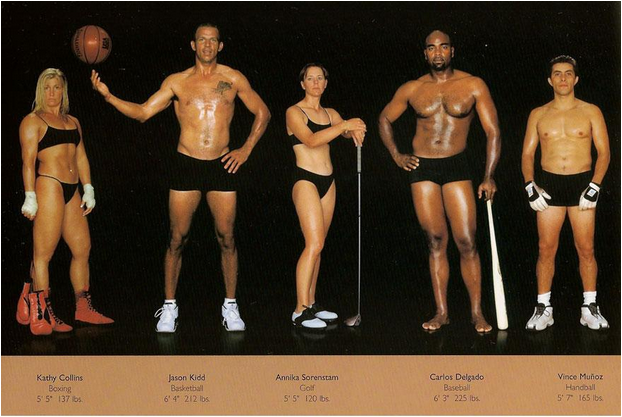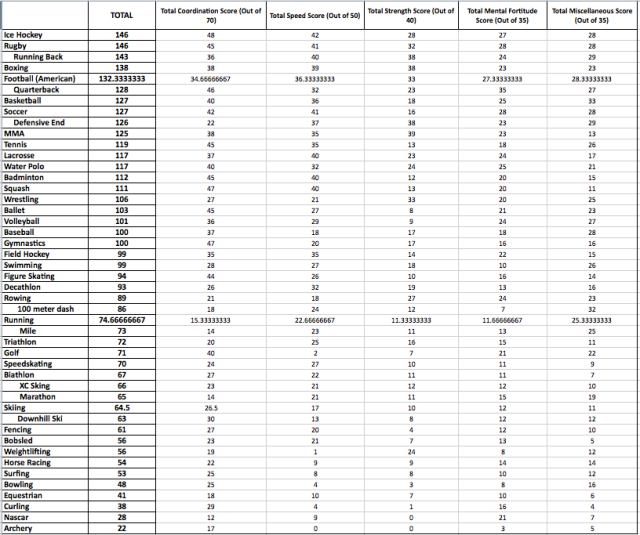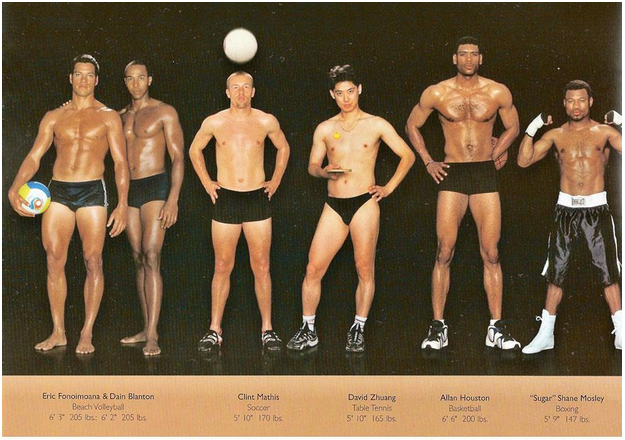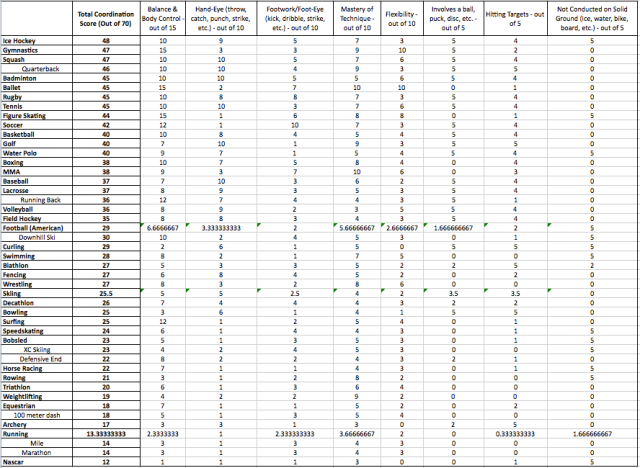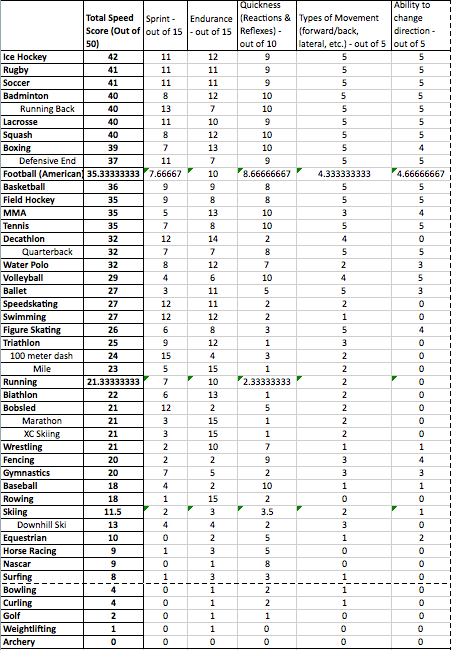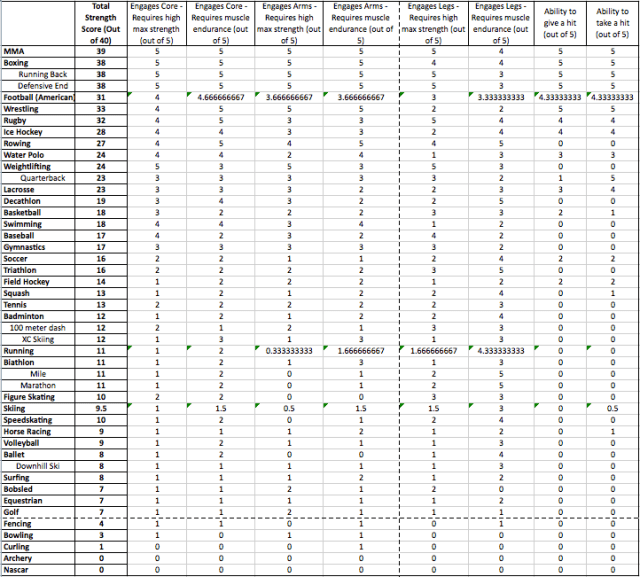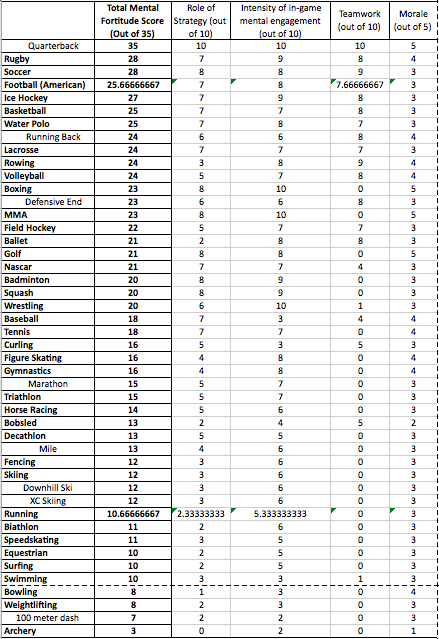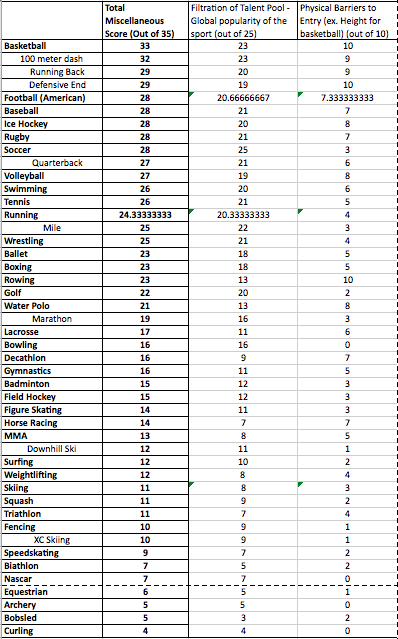What’s the most athletic sport? The answer is certain to ruffle feathers.
It’s an ego thing.
People want the sports they’ve played to receive sufficient respect. Because having dominated a “more athletic” sport makes you “more athletic,” right?
And some sports just hate each other.
Baseball vs. Lacrosse gets members of both parties riled up. In many high schools, these sports are played in the same season: spring. It frustrates a baseball player when the guy who would start as the Varsity Short Stop decides to play lacrosse. It eats away at a lacrosse player that baseball is more popular to the national media, thus rendering subjective lacrosse’s image as the “coolest spring sport.”
Soccer vs. Football is another feisty one. Again, high schools play these sports in the same season: fall. Football players are big and strong and use hands. Soccer players have endurance and use feet. This rivalry boils down to America vs. the World. Soccer is the world’s most popular sport. Football is America’s top darling and played nowhere else.
One reason this pride-fueled banter gets so heated is that there will never be a definitive Athleticism Index that proves arguments wrong and forces begrudging admissions of defeat. Any methodology would leave holes for prodding. There are too many arbitrary assumptions. How do you compare the importance of strength, speed, and coordination when defining “athleticism”? What’s the “more athletic” type of speed, sprinting ability or endurance?
Despite all that’s arbitrary, using scores for concrete metrics to assess sports’ athleticism provides a baseline. The Sopher Index is intended to start conversations, not end them.
Without further ado, the Sopher Index’s “Most Athletic Sport” goes to…
(drumroll)
… It’s a tie!
Ice hockey and rugby both notch 146 points (out of a possible 230 points).
The bronze medalist is boxing (138). American football[1] (132.33), basketball (127), soccer (127), mixed martial arts (125), tennis (119), lacrosse (117), and water polo (117) round out the top ten.
The bottom five sports – out of 38 total – are bowling (48 points), equestrian (41), curling (38), Nascar (28), and archery (22).
The Sopher Index measures athleticism using 27 variables belonging to the following five categories: Coordination (70 possible points); Speed (50); Strength (40); Mental Fortitude (35); and Miscellaneous (35). Variables are listed below by category, with the amount of possible points in parentheses:
1.) Coordination (70): Balance & Body Control (15); Hand-Eye Coordination (10); Footwork/Foot-Eye Coordination (10); Mastery of Technique (10); Flexibility (10); Involves a Ball, Puck, etc. (5); Hitting Targets (5); and Not Conducted on Solid Ground (5).
The most controversial part of this exercise is justifying how variables are weighted relative to one another. “Balance & Body Control” carries the most weight because it’s the most universal type of coordination. One needs a certain level of balance and body control to crawl and walk. While surfing and smashing a full-extension top-spin forehand are completely different activities, balance and body control is a uniter. Foot-eye and hand-eye coordination are weighted equally; sports heavy on footwork and those that involve throwing and catching neutralize each other. “Mastery of Technique” measures the importance of refined mechanics. Technique is essential for serving a tennis ball, driving a golf ball, and performing a pirouette, but less vital when racing a car. “Flexibility” is self-explanatory, and relatively more important in sports, such as gymnastics and ballet, with intense body gyration. “Involves a Ball” and “Not Conducted on Solid Ground” are proxies for the requirement to learn an instrument through your sport. In hockey, these instruments include your stick, skates, and the puck. “Hitting Targets” is the most popular type of finesse coordination, but it only counts for 5 points because it’s also folded into hand-eye coordination and whether a sport has a ball. In fact, there is overlap among all the variables. For example, balance and body control folds into the other five.
2.) Speed (50): Sprint (15); Endurance (15); Quick Reactions and Reflexes (10); Types of Movement (5); and Ability to Change Directions (5).
This category’s variables are weighted higher the more general the skill. Sprinting speed and endurance are the two rawest forms of fast, whereas quickness and types of movement are more refined versions. While all require athleticism, the refined types of speed require a foundation in the general types, so the refined types are relatively less important in this index.
3.) Strength (40): Max Core Strength (5); Core Muscle Endurance (5); Max Arm Strength (5); Arm Muscle Endurance (5); Max Leg Strength (5); Leg Muscle Endurance (5); Ability to Give a Hit (5); and Ability to Take a Hit (5).
There are two major types of strength – maximum capability and muscle endurance – and three regions of the body to be strong – core, legs, and arms. Each type of strength and region receives an equal weight in this analysis. In addition, sports with hitting involve a different, disorienting type of strength – mental, technique-based, and heightened pain threshold. So the abilities to take and give a hit receive equal weights to all the other variables in this category.
4.) Mental Fortitude (35): Role of Strategy (10); Intensity of in-Game Mental Engagement (10); Teamwork (10); and Morale (5).
The brain is an often underrated athletic organ. Out-thinking the opponent is essential to many sports, and labor-intensive and exhausting. For this index, “Role of Strategy” is a proxy for preparation – the importance of watching film, developing a game plan, eating and sleeping properly, etc. “Intensity of In-Game Focus” measures the consistency, duration, and extent to which the participant must be alert at game time. In boxing and MMA, a momentary lapse of concentration equates to a devastating blow to the chin. Whereas in American football, plays last 5-10 seconds, there are 30 second breaks between plays, frequency of substitutions means many players don’t play every down, and the offense/defense is only on the field half the game. In baseball, you might be in left field for 2 hours and only see two fly balls. “Teamwork” measures how team-oriented a sport is. Sports that involve more teamwork are tougher mentally because they involve harnessing egos and uniting multiple minds around strategies and goals. Lastly, in some sports, such as golf and baseball, “Morale” is disproportionately important. For this analysis, “Role of Strategy,” “Intensity of in-Game Focus,” and “Teamwork” are weighted equally, while “Morale” receives half the weight because, while important, it’s folded into the other three.
5.) Miscellaneous (35): Global Popularity of the Sport (25); and Physical Barriers to Entry (10).
A sport’s global popularity is the most heavily weighted variable in this index, and it is a proxy for the filtration of a sport’s talent pool. It’s more difficult to become the best at a sport played by more people. When competition is stronger, the game evolves to a more refined state requiring more impressive athleticism. More people in the world play soccer than any other sport, so its score is 25. Basketball is second place with 23. While global popularity is this category’s driver, scores for NFL quarterback (21), running back (20), and defensive end (19) are inflated by about 4 points each. Why? Because I’ve read NFL combine scores. These guys are freaks. Even if NFL football doesn’t have bowling’s global popularity, the NFL talent pool is more filtered.
Sports with high barriers to entry are those that cater to specific body types. For example, volleyball, rowing, and basketball cater to tall people. Football and hockey cater to big people. For this analysis, having a high barrier to entry helps the sport’s score. If a sport has a high concentration of people with bodies that are suited for that game, it does not mean these athletes are less suited for other games. It just means these athletes are better suited for one more game than the typical person and, thus, more athletic in a way. Strong counter-logic does exist, however: If a game caters to a specific body type, the population that could get good at the game shrinks, so the talent pool is less filtered.
Kiwi’s and Canadians better make good lawyers. As they’re the big winners, I expect they’ll be the ones defending the Sopher Index!
[1] American football is tricky to measure because the positions on the field require differing skill sets. For this analysis, American football’s score is the weighted average of running backs, quarterbacks, and defensive ends. These are three of the most athletic positions on the field, so I fear football’s score may be a generous. Other sports that are comprised of weighted averages are skiing and running. Skiing’s score averages downhill skiing and cross country skiing. Running’s score average the 100 meter dash, the mile, and a marathon.

